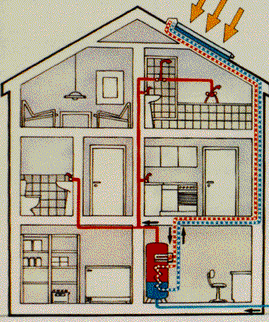liquid-based active solar heating

Solar liquid collectors are most appropriate for central heating. They are the same as those used in solar domestic water heating systems. Flat-plate collectors are the most common, but evacuated tube and concentrating collectors are also available. In the collector, a heat transfer fluid such as water, antifreeze (usually non-toxic propylene glycol), or other type of liquid absorbs the solar heat. At the appropriate time, a controller operates a circulating pump to move the fluid through the collector.
The liquid flows rapidly through the collectors, so its temperature only increases 10°–20°F (5.6°–11°C ) as it moves through the collector. Heating a smaller volume of liquid to a higher temperature increases heat loss from the collector and decreases the efficiency of the system. The liquid flows to either a storage tank or a heat exchanger for immediate use. Other system components include piping, pumps, valves, an expansion tank, a heat exchanger, a storage tank, and controls.
The flow rate through the collector should be between 0.02 and 0.03 gallons per minute per square foot of collector when water is the heat transfer fluid (0.82 to 1.22 liters per minute per square meter of collector). Other flow rates apply for different heat transfer fluids. The total flow rate, used to size the collector pump, is the product of the above flow rate times the total collector area. To learn more about types of liquid solar collectors, their sizing, maintenance, and other issues, see the solar water heating entry.
Storing heat in liquid systems
Liquid systems store solar heat in tanks of water or in the masonry mass of a radiant slab system. In tank type storage systems, heat from the working fluid transfers to a distribution fluid in a heat exchanger exterior to or within the tank.
Most storage tanks require 1–2 gallons (3.8–7.6 liters) of water for each square foot (0.093 square meter) of collector area. Tanks are pressurized or unpressurized, and the type used depends on the overall system design. Before choosing a storage tank, you should consider several factors, including cost, size, durability, where to place it (in the basement or outside), and how to install it. You may need to construct a tank on-site if a tank of the necessary size will not fit through existing doorways. Tanks also have limits for temperature and pressure, and must meet local building, plumbing, and mechanical codes. You should also note how much insulation is necessary to prevent excessive heat loss, and what kind of protective coating or sealing is necessary to avoid corrosion or leaks.
Specialty or custom tanks may be necessary in systems with very large storage requirements. They are usually stainless steel, fiberglass, or high temperature plastic. Concrete and wood (hot tub) tanks are also options. Each type of tank has its advantages and disadvantages. All types require careful consideration for their location, due to their size and weight. It may be more practical to use several smaller tanks rather than one large one. The simplest storage system option is to use standard domestic water heaters. They are designed to meet building codes for pressure vessel requirements, are lined to inhibit corrosion, and designed so it is easy to attach pipes and fittings.
Distributing heat for liquid systems
There are different ways to distribute the solar heat: with a radiant floor, with hot water baseboards or radiators, or with a central forced-air system. In a radiant floor system, a solar-heated liquid circulates through pipes embedded in a thin concrete slab floor, which then radiates heat to the room. Radiant floor heating is ideal for liquid solar systems because it performs well at relatively low temperatures. A carefully designed system may not need a separate heat storage tank, though most systems do for temperature control. A conventional boiler or even a standard domestic water heater can supply backup heat. The slab is typically covered with tile. Radiant slab systems take longer to heat the home from a "cold start" than other types of heat distribution systems. Once they are operating, however, they provide a consistent level of heat. Carpeting and rugs will reduce the system's effectiveness. See the radiant heating section for more information.
Hot-water baseboards and radiators require water between 160° and 180°F (71° and 82°C) to effectively heat a room. Generally, flat-plate liquid collectors heat the transfer and distribution fluids to between 90° and 120°F (32° and 49°C). Therefore, using baseboards or radiators with a solar heating system requires that either the surface area of the baseboard or radiators be larger, that the solar-heated liquid be heated more with the backup system, or that a medium-temperature solar collector (such as an evacuated tube collector) be used.
It is possible to incorporate a liquid system into a forced-air heating system, and there are different options for doing so. The basic design is to place a liquid-to-air heat exchanger, or heating coil, in the main room-air return duct prior to the furnace. Air returning from the living space is heated as it passes over the solar heated liquid in the heat exchanger. Additional heat is supplied as necessary by the furnace. The coil must be large enough to transfer sufficient heat to the air at the lowest operating temperature of the collector.
